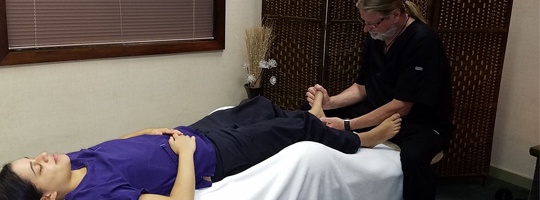
Reflexology can help reduce pain and increase energy. It is not a cure, but it can make the complications that arise due to Marfan easier to live with and thereby improve quality of life.
What is reflexology?
Reflexology is the method of working on the systems and organs of the body through the feet. Pressure is applied in a press and slide motion using the thumbs, fingers, and knuckles. It is non-invasive and is performed while the client is fully clothed. You need only to remove shoes and socks. It can be a very relaxing experience and some clients fall asleep before I begin on the other foot.
How does reflexology work?
When an imbalance occurs in the body, a deposit is formed immediately in the subcutaneous tissue (under the skin) in the corresponding reflex area of the foot. Thanks to the tireless efforts of Dr. Jesus Manzanares, a doctor and researcher from Barcelona, Spain, we now know what deposits consist of. His reflexology research in neuro-physiology at University Hospital Vall D’Hebron and Hospital Sagrado Corazon, Barcelona spans three decades and documentation of 70,000 clinical cases.
Dr. Manzanares found that deposits are made up of 42% nervous fiber, 28% vascular elements, and 30% connective tissue. Prior to his research, it was thought that deposits were toxins or crystals, inorganic material. He concluded that deposits were organic in nature.
There are three stages of a deposit:
1) Acute / 0-1 month. Deposits are not palpable, but the area is painful.
2) Sub-acute / 1-3 months. Less pain and easily felt deposits
3) Chronic / 3 plus months. Deposits are easily felt and the area gives a low level of pain.
Imbalances in people with Marfan syndrome may be related to chronic fatigue and pain. The reflexologist works on the feet in areas that correspond to these issues. When a deposit is felt, he or she massages the area, pressing and sliding across it long enough for signals to be sent to the brain. The brain’s reaction is then to respond with a different set of signals that are directed to the body part that corresponds with chronic fatigue and pain.
How can reflexology help?
Reflexology can help in these areas.
- Increased range of motion
- Cessation of or decreased pain
- Increased energy
- Decreased fatigue
- Increased relaxation
- Increased balance
- Reduction of stress
- Improved sleep patterns
How can reflexology be used in Marfan syndrome and related disorders?
I’ve had the pleasure of working on people with traumatic brain injury, stroke, Friedrichs Ataxia (a rare, inherited disease that causes nervous system damage and impaired muscle coordination), fibromyalgia, and irregular sleep patterns. All reported improvement in their symptoms.
Pain and fatigue are two issues in Marfan syndrome that affect the quality of life. Reflexology can address these issues simply by working specific areas of the feet. In my clients who suffer from pain and fatigue (without Marfan syndrome), improvements can usually be noticed after the first or second session with six to eight sessions being enough to bring a permanent change.

Ken Cook, of Gainesville, FL, was introduced to reflexology while attending the Florida School of Massage. The following year he attended the Academy of Ancient Reflexology and became a certified reflexologist. He is currently training under Dr. Manzanares of Barcelona, Spain.
